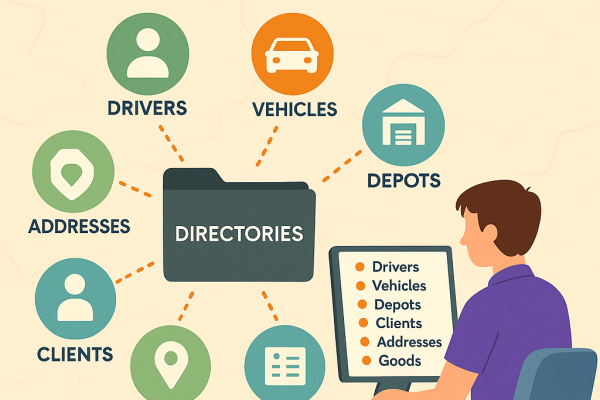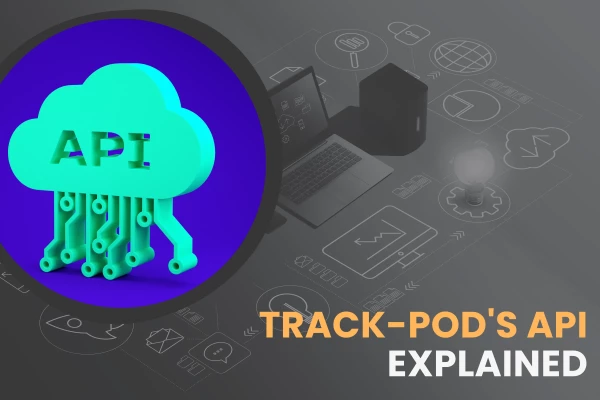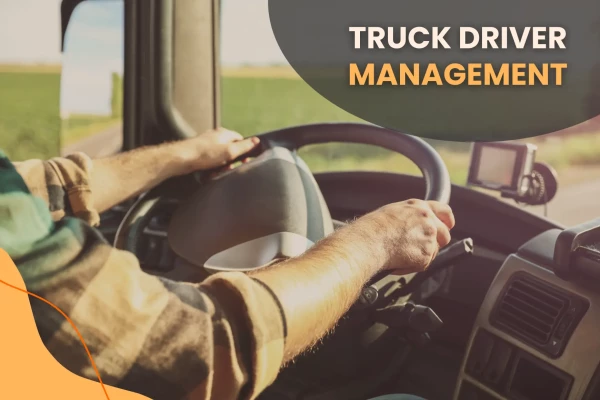Delivery Software and ERPs: Why Integration Is Important

by
Yulia Miashkova
July 27, 2021
When people think about what goes into getting a delivery to their doorstep, API integration or ERP systems aren’t commonly at the top of the list. Customers and clients care much more about their delivery tracking app or communication channel than they do about integration software…that’s if they even put any thought into that side of delivery systems.
For the businesses making these deliveries, the last leg of the product life, the trip to the customer, is literally at the end of their list. There are so many systems, operations, tasks, and processes that take place before this and they all need to be managed effectively. This is virtually impossible without enterprise resource planning (ERP). ERPs are integral to business management. Here’s why.
What is delivery software?
Before we get into the meat of ERPs, let’s take a look at one half of this article’s focus: delivery software.
Delivery software or delivery management software is a logistics solution that businesses can use to organize and optimize their delivery system.
Whether the organization is a delivery business, or it has a delivery wing, delivery software facilitates the smooth running of all dispatching operations.
Using delivery software, you can oversee and execute various actions across your product delivery cycle. To support you in doing this, the software will combine numerous features into one digital package.
Common features that most delivery software systems will incorporate include route optimization, route planning, communication channels, customer support services, GPS navigation and tracking, and API integration.
Transport management software vs delivery software
People generally make the mistake of confusing delivery software with transportation management systems (TMS) and fleet management systems. While it can work hand-in-hand with these structures, delivery software is different as it is specifically designed to nurture instinctive and efficient delivery activities.
A transport management system is also a logistics solution. However, it differs in its intention and focus. A TMS works with the planning, supervising, and implementation of transportation and/or shipments. In contrast to a delivery system’s focus on the organization’s internal fleet, a transport management system can tend to be more externally focused. Some of the things you can handle on your TMS include external shipment fleets, customs procedures, policies, etc.
Although some TMS systems do take a more internal approach, they are not dedicated to delivery optimization as a delivery software solution would be.
Fleet management software vs delivery software
A fleet management software solution is a digital logistics tool used to manage and coordinate fleets as well as delivery operations. Fleet systems like delivery software enable managers at HQ or warehouses to remain in communication with drivers or delivery fleets on the road.
Unlike delivery management software, however, fleet management software does not take an active engagement approach to deal with on-the-road challenges. While a delivery management software system would seek to deal with issues as they happen, a fleet management system would be more focused on resolving the issue after it occurs.
Thus, this kind of software is often utilized as a data collection tool. The data can be used for insurance purposes, to provide recorded evidence when necessary. It can also be used to improve fleet safety. With access to valuable data and insight into driver habits, behavior, and vehicle data, you can identify safety issues or the causes of accidents. This can help you manage truck drivers and guide them on how to avoid unsafe conditions in the future.
Thus, delivery management software behaves more intuitively, responding to delivery issues almost instantly. Unlike transport management and fleet management systems, delivery software can help you manage deliveries more holistically. It is a delivery all-rounder with amazing capabilities and benefits.

Benefits of using delivery software
There are hundreds, if not thousands, of different systems and models that businesses use to modernize and optimize deliveries. While they may contribute to more productive delivery practices, very few are more beneficial to delivery organizations than delivery software. Below are some of the benefits your organization can gain from using Track-POD’s delivery software.
-
Automation.
-
Centralized, streamlined operations.
-
Real-time driver and vehicle tracking.
-
GPS navigation.
-
Analytics and reporting.
-
Route planning and route optimization for safer and faster routes.
-
Order and inventory management integrations.
-
Cost reduction.
-
Cloud database.
-
Communication and connectivity.
-
Customer satisfaction and improved customer service.
Through delivery software, you can establish a dispatching and package delivery model that is efficient, convenient, and profit-smart.
Furthermore, the software provides support and transparency to all the actors involved in your delivery process: manager, customer, and driver. With clear communication and accessibility, even when a delivery doesn’t go according to plan, everybody stays informed which leads to a lot less frustration and confusion.
Who can use delivery management software?
There is no limitation of the kinds of businesses or industries that can benefit from using dispatching systems. Software companies can often tailor delivery software to a company’s needs and wants, making it possible for various industries and businesses to use dispatching and delivery systems for their organizations. What follows are examples of the industries that greatly benefit from using delivery software include.
-
Fleet management.
-
Transport management.
-
Logistics and supply chain.
-
Service providers like cleaning, cosmetics, beauty, etc.
-
Fitness and health businesses.
-
E-commerce, retail, and online shopping.
-
Pharma.
-
Food and beverages.
-
Perishables.
Now that you understand what delivery software is and how your business can benefit from using it, we can take a look at what ERPs are and how they fit into your delivery system.
What is an ERP?
Enterprise resource planning (ERP) is a term used to describe software used by businesses and institutions to coordinate their daily activities. An ERP brings various day-to-day functions together, simplifying data flow and visibility and unifying business processes. Your ERP can combine your procurement, supply chain, accounting, compliance, and other processes that form your business’ core.
Although enterprise resource planning sounds like a very specific process, what an ERP essentially does is manage and monitor the data from numerous core business processes. With a performance management component in your ERP, you can also direct your business using plans, reports, and predictions based on your organization’s data and financial information.
Additionally, integrating a financial service CRM into your ERP can further enhance your ability to manage customer relationships and financial data effectively.
Your ERP also helps automate some of these processes for greater efficiency. By unifying your processes and their resultant data, your business can rely on a single, dependable data source.
Simply put, ERP software intertwines your business into one platform that’s easier to manage.
Benefits of using ERPs
It is clear from the definition above that ERPs have the potential to greatly improve and advance your business operations. The effects of ERP systems on businesses are unmistakable.
-
Better business insights.
-
Informed and data-driven decision-making.
-
Reduced operational costs due to streamlined functions and decreased operational costs.
-
Easier and consistent user experience leading to better functionality and understanding across employees and departments.
-
Enhanced efficiency as a result of improved business processes and functionality.
-
Decreased risks thanks to information access, data reliability, and financial management.
These are some of the benefits that ERPs provide to organizations no matter how they use them. How do enterprise resource planning and delivery software come together for the better of your delivery management? Let’s take a look.
Benefits of integrating ERP and delivery software
Integrating these two systems means bringing together their respective benefits for the better of your business. With delivery software and ERP systems working together your business can improve in the following aspects of its delivery operations.
Order fulfillment
Order fulfillment is a fundamental component of eCommerce operations and delivery systems. Customers need to remain informed about their orders. You also want to assure your customers that their dispatches would be swift and efficient. Having your ERP integrated with your delivery software allows for order fulfillment automation.

Dispatching
Dispatching processes can also benefit from delivery software-ERP integration. Track-POD can work with incoming orders, driver schedules, and other systems to ensure that dispatching remains quick and efficient, too. Drivers get instant, automated notifications regarding packages that are ready for dispatch.
Productivity
Not only can this delivery software and ERP relationship enhance your dispatching and order fulfillment efficiency, but it can also assist your team in boosting productivity. With automation capabilities, some repetitive processes that take up your employees’ time can be delegated to your system instead.
For example, driver dispatching and order allocation would have required your workers’ time. Instead, the software systems take care of it.
Data visibility
A huge benefit of integrating these systems is the power it gives you over your data. The delivery software gives you access to shipment analytics like vehicle data, distance covered, Proof of Delivery documents, and more. ERPs increase the visibility of data from other business processes like your accounting department and more.
With these integrated, you can make the necessary data visible to the relevant department. For example, your ERP can automate invoices for the accounting department, making delivery income tracking simpler. Your data also becomes more accessible through digital databases like a cloud platform.
Time management
Overall, the efficiency of your delivery operations and the automation lead to better time management. You can spend and plan your business’ time by drastically reducing employee workload and optimizing dispatching and order fulfillment.
Customer service
All of these benefits have a direct impact on your customer service provision. Quicker order management and better dispatching mean customers can get their hands on their packages much faster. Improved data visibility and employee productivity allow you to focus on improving other aspects of your customer experience. Better access to data also makes it easier to get customers the information they need when they need it.
How API integration works in Track-POD
Track-POD's delivery management software allows you to integrate your ERP into its system. You can complete ERP integration with Track-POD without having to input any data manually. The API integration offers a simple HTTP interface through WEB XML Service or JSON.
Not only can you integrate your ERP, but you can also integrate other useful business software systems. Track-POD allows you to integrate various platforms using API integration.
-
Inventory management software.
-
Order management software.
-
Customer relationship management (CRM) systems.
-
eCommerce management platforms like Shopify.
You can also integrate over two thousand apps via Zapier. Zapier immediately links Track-POD with over two thousand apps. You can automate these platforms, boosting your productivity substantially.
Using Track-POD’s API integration, you can also automate data imports and exports as you need to. You can import order information, and ready-planned routes onto your Track-POD solution. As the platform also collects important data and information, you can export data for easy use. Automating data flow for a specific app is also possible, giving you more power over the movement of your data.
Final thoughts
Managing a delivery system takes a lot of hard work and dedication. Beyond that, however, it takes brilliant management and organization, foresight, and intuitive responses to challenges.
There are many ways to improve these qualities manually and using different business management models. However, the digital age has come with unique challenges and demands that often require innovative and technological digital solutions.
By integrating your delivery software and enterprise resource planning system, you can advance your delivery operations. This integration can bring your management and delivery performance up to scratch, helping you meet increasingly challenging customer demands.
With this combination of digital technologies, you can streamline your delivery operations and general business process, and drive your company into the future with data-driven decision-making from reports and insights.
- Transportation management
About The Author
Yulia Miashkova
Growth marketing manager with a background in public relations, SEO, social listening, and Account-Based Marketing.







